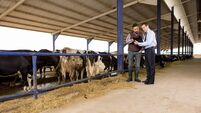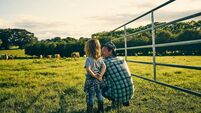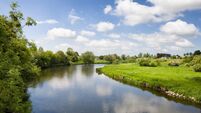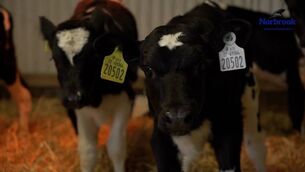Think safety first as each day starts on your family farm

, Minister of State with responsibility for Research and Development, Farm Safety, and New Market Development, offers farmers advice on how to keep their families safe

Over the last ten years (between 2010 and 2019), some 21 children have lost their lives on Irish farms.
To date in 2020, three of the 16 fatal incidents that have occurred on farms, resulted in the death of a child.
These are horrific statistics and dreadful tragedies for the families involved. It is time to make a change.
As the first Minister with specific responsibility for Farm Safety I am acutely aware that things need to change.
As a father of three small boys who are growing up on our family farm, I also know the risks involved. Farms are the most hazardous workplaces in Ireland. While the vast majority of farms are also family homes, farms and farmyards are not playgrounds.
Farms and farmyards have many risks and dangers for children. Children need to be kept under close supervision at all times. Over 80% of all incidents that resulted in the death of a child in the last ten years have involved either a farm vehicle or machinery.
It is important that children are never allowed around a farmyard without a responsible adult being with them. This means not having children in tractors. Children do not see the dangers that are present, and do not understand that the operators of large farm vehicles and machinery are unlikely to be able to see them approaching.

It is also important that parents and family members think carefully about taking pictures of children around farm vehicles and machinery and posting them on social media.
It gives the wrong impression that this may somehow be a safe place for a child to be. It is not appropriate to show pictures of children around farm machinery at any time.
This does not just apply to parents and family members. It is important that all publishers and media organisations think very carefully about the pictures they publish, in any format.
Children do not understand the dangers with machinery. Just because a machine is not operating does not mean that it is safe. It must become socially unacceptable to have children in the vicinity of machinery.
It is only by keeping children away from machinery at all times, that the number of serious and fatal accidents involving children will be reduced. Every one of us has a role to play in reducing the number of serious and fatal incidents involving children on Irish farms.
We all have a responsibility to ensure safe practices are adhered to at all times. We should call out unsafe practices when we see them. The overall responsibility for securing the safety and health of children and young people on farms rests with us adults. A secure and safe play area for young children should be provided.
You might at this stage be thinking where can you get information and advice in relation to keeping my children safe on my farm. There is a huge amount of information available.
My Department’s website, along with the HSA’s and Teagasc’s websites all have information in relation to child safety on farms. There is information suitable for both adults and children.
There are books for adults to read with children, aimed to teach children the dangers that may be present on farms. There are videos for adults and children to watch together, to highlight potential dangers that may be present.
The websites also give information in relation to your legal responsibilities around keeping children safe, and what young people can do on your farms. There are also organisations like, AgriKids and Agri-Aware that provide information in relation to child safety that can be used in both the home and at school.
Agri-kids have a series of books on farm safety for children to highlight the potential dangers and give information on how to stay safe. Agri-Aware have built farm safety into both their primary and secondary level modules for agriculture for schools. Everyone involved in farming should take time to look up all the information and to watch the videos.
For older children, over 14, who are looking to start working with tractors on farms, it is important that they should be correctly trained in how to drive a tractor. They should receive formal training on tractor driving.
It is not appropriate to let young people start to drive tractors unless they have been formally trained by a competent training organisation. Organisations like FRS run formal tractor driver training courses for young people. It is important that they understand the dangers associated with driving a tractor and how to handle both the tractor and any machinery attached to it.

It is important that young people start on smaller tractors and in a safe environment. Putting a young person directly on to a powerful tractor is looking for an incident to occur. Remember, as the farm owner you are responsible for ensuring that anyone operating a tractor or machine has been correctly and fully trained in the operation of that tractor and machine and ensure that the operator is capable of safely using the machine.
When considering safety on your farm, you should be looking at all aspects. It is not good enough to have just one aspect of health and safety dealt with. You have to ensure all areas and tasks are safe.
There are different risks for adults and children, but everything needs to be addressed. It is not good enough to just be aware of the risks that are on your farm. You need to undertake the work to remove the risks.
This may be as simple as fixing the bolt on the gate, changing the twine for a chain, repair the PTO cover or replacing the damaged manhole cover. None of these are expensive things to do, and all could save your life or the life of someone you love.
Is it really too much to ask to take time to ensure that your farmyard and machinery is safe? By doing the simple things and keeping the farmyard clean and tidy, the risks that lead to accidents will be reduced.
This also means keeping the children out of the farmyard unless they are under the close supervision of a responsible adult, not carrying children in a tractor cab or on any machinery and undertaking a detailed and honest appraisal of the safety risks on your farm.

When doing a risk assessment, you should get someone in to do the risk assessment with you.
Fresh eyes will see risks that you have become accustomed too and no longer realise are present. Once the risk assessment has been completed, you need to start continuously working to remove and contain all of the risks.
It is not good enough to leave it on the long finger. Remember, some of the safety changes will be about how you do things, like reverse parking, rather than upgrading equipment or buildings – routine maintenance is about providing a safe working environment for you and anyone visiting your farm.
Remember, farm safety must be thought about every morning, before you go out into the yard. It should be a first thought and not an after thought. You should always plan your work.
This means that you should stop and think “how am I going to do this job and do I have everything I need”.
It does not cost anything and only takes a few minutes. It does, however, require conscious reflection on farm safety every single day, and before every single job is tackled.
This way not only do you protect yourself, but you protect any children and other people who enter your farm.

www.agriculture.gov.ie/farmsafety/











